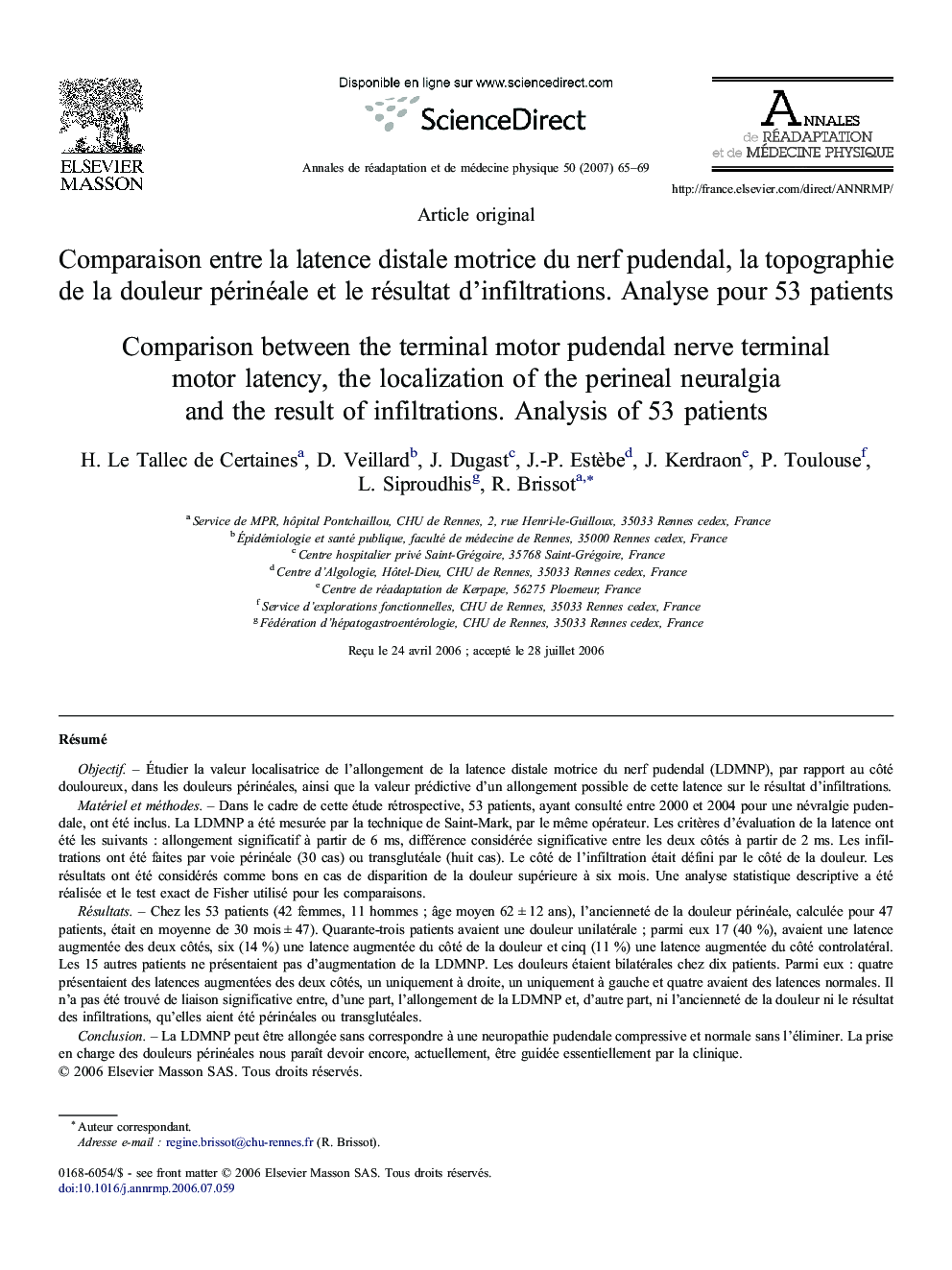| کد مقاله | کد نشریه | سال انتشار | مقاله انگلیسی | نسخه تمام متن |
|---|---|---|---|---|
| 4040300 | 1264299 | 2007 | 5 صفحه PDF | دانلود رایگان |

RésuméObjectifÉtudier la valeur localisatrice de l'allongement de la latence distale motrice du nerf pudendal (LDMNP), par rapport au côté douloureux, dans les douleurs périnéales, ainsi que la valeur prédictive d'un allongement possible de cette latence sur le résultat d'infiltrations.Matériel et méthodesDans le cadre de cette étude rétrospective, 53 patients, ayant consulté entre 2000 et 2004 pour une névralgie pudendale, ont été inclus. La LDMNP a été mesurée par la technique de Saint-Mark, par le même opérateur. Les critères d'évaluation de la latence ont été les suivants : allongement significatif à partir de 6 ms, différence considérée significative entre les deux côtés à partir de 2 ms. Les infiltrations ont été faites par voie périnéale (30 cas) ou transglutéale (huit cas). Le côté de l'infiltration était défini par le côté de la douleur. Les résultats ont été considérés comme bons en cas de disparition de la douleur supérieure à six mois. Une analyse statistique descriptive a été réalisée et le test exact de Fisher utilisé pour les comparaisons.RésultatsChez les 53 patients (42 femmes, 11 hommes ; âge moyen 62 ± 12 ans), l'ancienneté de la douleur périnéale, calculée pour 47 patients, était en moyenne de 30 mois ± 47). Quarante-trois patients avaient une douleur unilatérale ; parmi eux 17 (40 %), avaient une latence augmentée des deux côtés, six (14 %) une latence augmentée du côté de la douleur et cinq (11 %) une latence augmentée du côté controlatéral. Les 15 autres patients ne présentaient pas d'augmentation de la LDMNP. Les douleurs étaient bilatérales chez dix patients. Parmi eux : quatre présentaient des latences augmentées des deux côtés, un uniquement à droite, un uniquement à gauche et quatre avaient des latences normales. Il n'a pas été trouvé de liaison significative entre, d'une part, l'allongement de la LDMNP et, d'autre part, ni l'ancienneté de la douleur ni le résultat des infiltrations, qu'elles aient été périnéales ou transglutéales.ConclusionLa LDMNP peut être allongée sans correspondre à une neuropathie pudendale compressive et normale sans l'éliminer. La prise en charge des douleurs périnéales nous paraît devoir encore, actuellement, être guidée essentiellement par la clinique.
AimThe aim is to study the value of the pudendal nerve terminal motor latency (PNTML) testing, in respect to the painful side in patients with pudenda neuralgia, and to determine whether a possible increased latency in the painful side is predictive of a good result with the infiltration.MethodThis retrospective study included 53 outpatients (42 women, mean age 62) with suffering from pudendal neuralgia, who were seen between 2000 and 2004. The mean duration of the pain was 30 ± 47 months. The PNTMPNL was measured by the Saint-Mark hospital technique, by the same operator. The following criteria have been were defined: significant increased latency greater than above 6 ms, significant difference of 2 ms in latency between 2 sides from 2 ms, and side of the infiltration corresponding to the side of the neuralgia. The infiltrations were performed either by perineal (30 cases) or transgluteal (8 cases) way. The results on pain were have been considered as good when a substantial reduction of the pain was observed for 6 months or more. Statistical analysis involved was done by the exact Fischer's test to seek for a possible relation between variables.ResultsOf 53 patients (42 women, 11 men, mean age 62) suffered from a with perineal neuralgia. The duration of the neuralgia was 30 ± 47 months. It was bilateral in 10 cases and unilateral in 43 cases. In 43 patients with When the pain was unilateral pain, PNTML we find that the MDLPN was increased in both sides in 39.5% of the population, in the painful side in 14% and in the side opposite side of the to pain in 11%. In 10 patients with the neuralgia was bilateral pain, in 10 patients. Among then, 4 had a bilateral increase of the latency, one patient had an increase only on the right side, and another one an increase only on the left side. We did not find any correlation between the increased of the PNTML TMPNL and, either neither the duration of the neuralgia nor the result of the infiltrations, whatever the method way of the infiltration.ConclusionThe PNTML can be increased whether it corresponds or not to an entrapment of the pudendal nerve. Thus, the management of perineal pain is based mainly, from us, on clinical findings.
Journal: Annales de Réadaptation et de Médecine Physique - Volume 50, Issue 2, March 2007, Pages 65–69